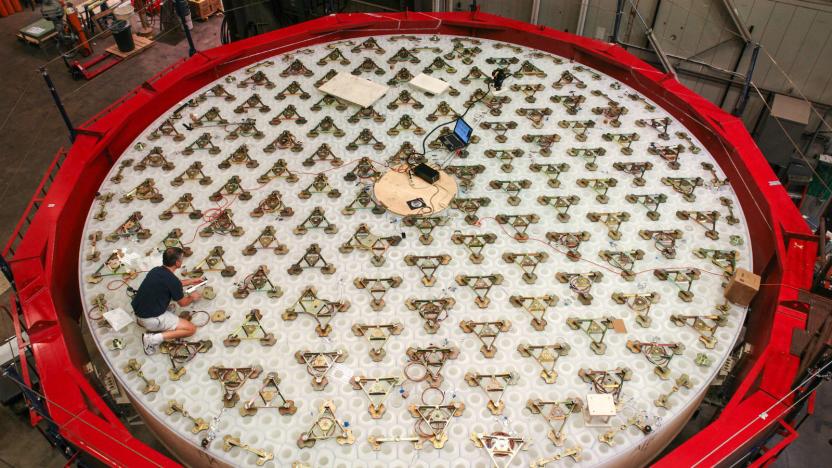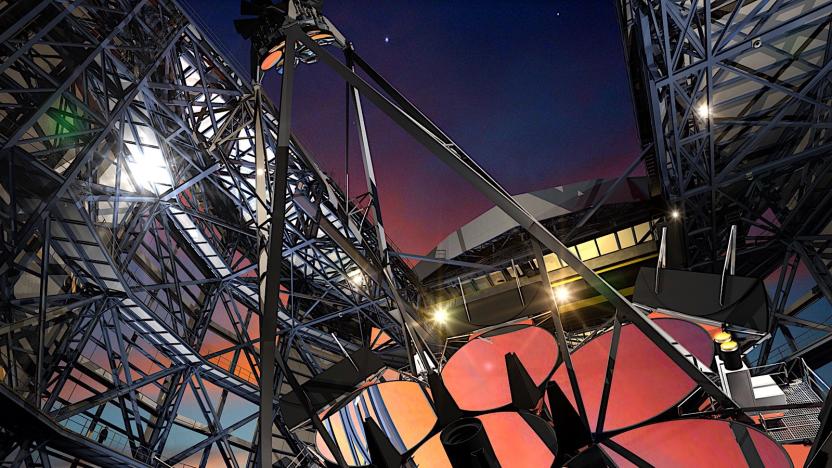University of Arizona
Latest

The world's largest telescope is edging closer to completion
This week, the University of Arizona's Steward Observatory Mirror Lab began work on the sixth of seven primary mirror segments for the Giant Magellan Telescope (GMT).

The virusbuster boom
Disinfecting services like Enviro-Master are having a moment, but how long will it last? Omar L. Gallaga joins the company as it cleans up a Chick-fil-A.

Supercomputer creates millions of virtual universes
How do you understand the development of galaxies when even the younger examples are frequently billions of years old? Simulate as many universes as you can, apparently. Researchers at the University of Arizona have used the school's Ocelote supercomputer as a "UniverseMachine" that generates millions of mini universes to see how well they line up with the real cosmos. Rather than try to portray every nuance of the whole universe (even a single fully modeled galaxy would require far too much computing power), the team devised a system that had just enough resolution to scale from supernovae to a "sizeable chunk" of observed space. Each virtual universe had a different set of rules, and it was largely a matter of seeing which simulations lined up the closest with real data.

The world’s largest telescope is one step closer to completion
The world's largest telescope is one step closer to completion. This month, the team working on the Giant Magellan Telescope (GMT) completed the second of seven primary mirror segments, a process that began in January 2012.

The world's largest telescope will unlock the universe's oldest secrets
In the predawn hours of September 20th, 2017, the cavernous hangar doors of the Richard F. Caris Mirror Lab at the University of Arizona slowly swung open and the first of seven gargantuan mirrors passed through on its way to the Las Campanas Observatory in Chile where they will be assembled into one of the largest star-gazing instruments ever constructed: the Giant Magellan Telescope (GMT).

'Asteroid Day' is a good time to learn about the threat of space rocks
On June 30th, 1908, more than 770 square miles of remote Russian forest were obliterated from the face of the Earth when a relatively small meteor, estimated at only around 400 feet across, unleashed 15 megatons of energy above the Stony Tunguska River. One hundred and nine years later, humanity knows precious little more about the dangers that lurk within our solar system than we did in 1908. But a recently founded "global day of education" aims to bring the existential threat that space rocks pose to the forefront of our collective consciousness.

Robotic legs simulate our neural system, lurch along in the most human-like way so far
We've seen some pretty wonky bipedal robots before, but scientists at the University of Arizona have gone straight to the source -- us -- to make one with a more human-like saunter. It turns out it's not just our skull-borne computer that controls gait: a simple neural network in the lumber area of our spine, called the central pattern generator (CPG), also fires to provide the necessary rhythm. By creating a basic digital version of that and connecting some feedback sensors in the legs, a more natural human stride (without balance) was created -- and on top of that it didn't require the tricky processing used in other striding bots. Apparently this throws light on why babies can make that cute walking motion even before they toddle in earnest, since the necessary CPG system comes pre-installed from birth. That means the study could lead to new ways of stimulating that region to help those with spinal cord injuries re-learn to walk, and produce better, less complex walking robots to boot. Judging by the video, it's a good start, but there's still a ways to go before they can mimic us exactly -- you can watch it after the break.

UA engineers develop 'invisible,' fiber optic border monitoring system
As if the nation's overexcited and misguided border vigilantes didn't have enough ways to trigger alarms and bedevil the U.S. Border Patrol (whose job is hard enough as it is), University of Arizona researchers have developed Helios, a monitoring system that uses an acoustic sensor to detect movement via fiber optic cables buried beneath the US-Mexico border. The system is evidently able to distinguish between vehicles, animals, and humans -- and it can even differentiate between different types of human activity, including walking, running, and digging. But that ain't all! UA is looking to spin the technology out into the private sector, working with a company called Fotech to automate the system, further refine the database of signals, and maybe even integrate this into a comprehensive border security system complete with mobile surveillance vehicles and an animatronic Jan Brewer that is, according to a guy we overheard at the bar, "only slightly more human than the actual Arizona governor."

Dynamic 3D holograms can now refresh every two seconds, save galaxies in their spare time
Perhaps the biggest challenge in making holograms usable on a daily basis -- aside from having to film your subject with a million trillion cameras -- is in getting their refresh rates up to the levels we're used to with "normal" two-dimensional video. We're still a fair way away from those magical 30fps, but the University of Arizona is touting a heretofore unheard of redraw rate of once every two seconds. This is a major advance from their first dynamic holograms demonstrated two years ago, which required minutes to swap over to a new image. The current prototype is built on a 10-inch photorefractive polymer screen, with lasers beaming information onto it, though 17-inch versions are also being tested. Another present limitation is that the hologram displayed can only be of one color, but that is also subject to the continuing labors of the UA researchers, who foresee no major hurdles preventing them from eventually cobbling together full-color, fast-refreshing, and fully realized 3D holograms. Now that'd be 3D television we can all get behind. Or in front of, depending on the viewing angle we want.

History of Earth in Second Life
Thanks to my friend Graham I found out about an exhibit covering the history of the Earth, both geological and biological in Second Life, so I went to visit it yesterday. Pictured above is part of the display for my favourite organisms of all time: the weird and wonderful animals from the Burgess Shale and the Cambrian Explosion.The exhibit is attractively put together, and instructive. According to the NMC teachers buzz (that I missed in August) it was created solely by the students at the University of Arizona. Despite being instructive, I came away with a strong feeling of having visited a traditional museum, rather than an immersive exhibit in Second Life or an interactive science museum, or something moving towards Museum 2.0. There were certainly elements of the display, such as the exhibit about continental drift that I have seen done in an interactive fashion (I think at both Te Papa in Wellington and Cité des Sciences et de l'Industrie in Paris), which could have been done in a more interactive fashion here. Where were the chances to walk through the core, mantle and crust of the Earth rather than look at cut-away models that I remember from when I was at school, over 20 years ago?Despite, in my opinion, missing a trick or two that could have made this an excellent place to visit, it is still well worth a look. The SLURL will not take you straight there most of the time - you will land at a hub and be offered a teleport up from a large, almost impossible to miss, sign.

Dynamic holographic displays are finally here, a couple decades late
Face it, the past few decades of flat holograms have been a sham. Baseball cards? Security logos? Software piracy protection? This isn't what sci-fi had in mind at all. Thankfully, some University of Arizona scientists are getting the technology back on track with a new three-dimensional holographic display. What makes this one special is that the display is dynamic -- it can be rewritten with an entirely new image in a few minutes. Obviously the refresh rate's going to need some work before we're all chugging along on a holographic workstation, but it's certainly a start. The current prototype is 4-inch by 4-inch, and only displays in red, but the researchers believe a full color display is feasible, and they're already at work on a 1-foot by 1-foot version.

Robo-moth can't flap, still likes flames
We're no strangers to the use and abuse of insects in the name of science, but we've gotta say that this robo-moth mech is the best example yet. Built by a few mad scientists over at the University of Arizona, robo-moth intercepts signals sent by the moth's eyes to its teensy brain and turns them into movement. The bot can detect where the moth is looking, and turns in that direction. Since moths have quite the fancy pair of preceptors and built-in reflexes, it's going to allow for some pretty complicated actions once scientists figure out how to control more motion than left and right. Researchers are looking down the road to where a moth could act as a disposable bomb-sniffing robot, or where paralyzed humans could more accurately control wheelchairs with their thoughts, but that's all still a ways out.

Traffic simulation software lets officials plan evacuation strategies
The image of a backed-up highway leading away from the scene of a natural disaster may soon be history, if researcher Yi-Chang Chiu and his colleagues at the University of Arizona have their way. They've developed a traffic simulator that uses real-time traffic data along with detailed state and federal traffic statistics and behavior modeling to allow officials to simulate disaster evacuations in real time -- or even predict the course of events as a disaster is happening. The software adjusts for such varied data as driver reactions to radio reports and wind dispersal of smoke and other pollutants; it even calculates the number of casualties and their effect. Chiu has been building the simulator since 1995, and he's ready to start selling to state transportation and medical emergency agencies. Interestingly, Chiu says his real research focus is on calculating optimum "value-priced" toll rates -- something we're certain most state transportation departments regard as the real disaster.






